Solid waste management is one of the most vital tasks for any country to attain sustainable development.
Solid waste, also known as discarded trash, is any stable compound containing hazardous substances requiring collection, processing, and disposal in an environmentally safe manner.
This includes e wastes, plastics, foodstuffs, and other solid wastes generated by various industries, establishments, and households.
Rapid industrialization, economic development, high population density, and increased per capita income lead to high solid waste rates in developing countries like India.
The importance of solid waste management is that it reduces the amount of waste generated and helps protect human health and the surrounding environment.
This article will mainly focus on municipal solid waste (MSW) and discuss how to effectively manage them.
What is Solid Waste?
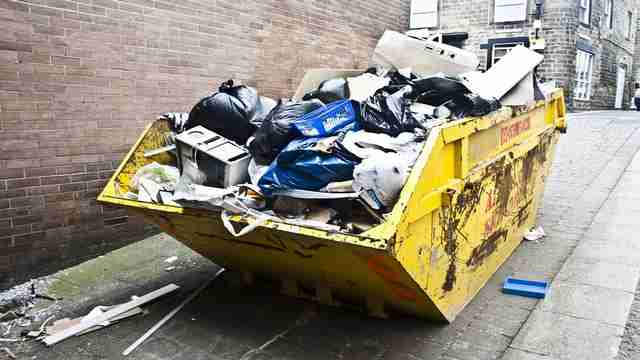
Solid waste is a type of discarded material that is no longer valuable to its initial user or waste generator, and it has served its intended purpose.
From the definition, it looks like the solid wastes must be solid in nature, but it is not true as per the EPA guidelines.
Many types of solid wastes are liquid, semisolid, or contained gaseous substances.
The Resource Conservation and Recovery Act (RCRA) §1004(27) defines solid waste as,
“Any garbage, refuse, sludge from a wastewater treatment plant, water supply treatment plant, or air pollution control facility, and other discarded material, including solid, liquid, semisolid, or contained gaseous material, resulting from industrial, commercial, mining, and agricultural operations and from community activities.”
| More to Read: |
Types of Solid Waste Generated in India
The classification of solid waste can be done in many ways according to its source, composition, treatment required, etc. which is given below;
| Municipal solid waste (MSW) | It includes solid waste generated in residential and commercial areas falling under the municipality.
This type of waste can include certain biomedical but exclude industrial hazardous waste. Municipal solid waste is managed by Municipal Solid Waste (Management & Handling) Rules, 2000. Developing countries like India generate approximately 0.4-0.9 kg waste per person a day, which is relatively less than high-income countries where generation ranges from 1.1-5 kg per person a day. There are some amount of plastic waste (viz. plastic bags, straws, bottles, etc.) mixed with the municipal waste as well. The composition of typical municipal solid waste is 51% organic, 21% inert, and balance 17% recyclables. |
| Industrial Waste | This is an unwanted waste material generated by any manufacturing units, power plants, process industries, etc.
It may be solid, liquid, sludge, or hazardous type waste. Usually, the industries are themselves responsible for their waste management that is quite effective. |
| Agricultural Waste | Various agricultural operations such as manuring and harvesting produce agricultural waste.
It also includes other types of waste from farms, poultry, and slaughterhouses. Various Indian states like Maharashtra & Uttar Pradesh have waste-to-energy plants that utilize agricultural waste for power production. |
| Hazardous Waste | This type of waste can harm the environment and human health if not treated properly.
It usually includes the type of waste that is reactive, flammable, toxic, explosive, or corrosive in nature. In India, small-scale industries usually dispose of hazardous waste and municipal waste due to the lack of infrastructure. In 1989, the Indian Government created Hazardous waste handling & management rules (revised in 2016) that require safe disposal and treatment. |
| Construction Waste | Waste generated from materials debris resulting from construction, repair, and demolition activities of roads, buildings, bridges, etc.
This type of wastes normally contains non-biodegradable materials such as concrete, metal, wood, plaster, and plastics that are usually mixed with municipal waste. This type of waste is managed by Construction and Demolition Waste Management Rules, 2016. |
| Electronic Waste | E waste is the outdated / discarded electrical or electronic equipment and its components without any intent of reuse.
It includes a wide variety of products ranging from any household item with circuitry (such as refrigerator, television, air conditioners, mobile, computers, etc.) and electrical/electronic components with power or battery supply. This type of waste contains many substances, (like lead, cadmium, beryllium, chromium) many of which are toxic to the environment and human health. E-Waste Management Rules, 2018 clarifies the duties of responsible parties, imposes strict guidelines on e-waste production, and clarifies the general definition of e-waste. |
| Biomedical waste | The biomedical waste consists of discarded materials generated from various biological and medical activities such as production, research, diagnosis, treatment, and immunization.
Hospitals, clinics, research facilities, education centers, production units, blood banks, pharmacies, and laboratories are responsible for producing biomedical waste. A recent study reveals that India is likely to generate about 775.5 tonnes of medical waste by 2022. Bio-Medical Waste (Management and Handling) Rules, 1998, states that bio-waste needs treatment in certain facilities that are specialized in incineration and autoclaving technology. |
| Battery Waste | Used and depleted batteries from vehicles, electronic equipment, and industries account for battery waste.
Battery waste contains heavy metals like lead, nickel, lithium, copper, etc. which require proper disposal methods. It is governed by battery waste management rules (2020). |
| Radioactive Waste | This type of waste contains radioactive substances that mainly come from nuclear power plants.
2014 data states that India generates around four tonnes of nuclear waste per gigawatt (GW) annually. This type of waste is managed by Atomic Energy (Safe Disposal of Radioactive Wastes) Rules, 1987. |
| Mining Waste | Opencast or underground mines generate such type of waste.
Metals, Chemicals, radioactive elements, and earth rejects are often generated as waste products. These solid wastes are not useful to the mine owners so they are often inappropriately disposed of. |
Municipal Solid Waste Management in India (MSW)
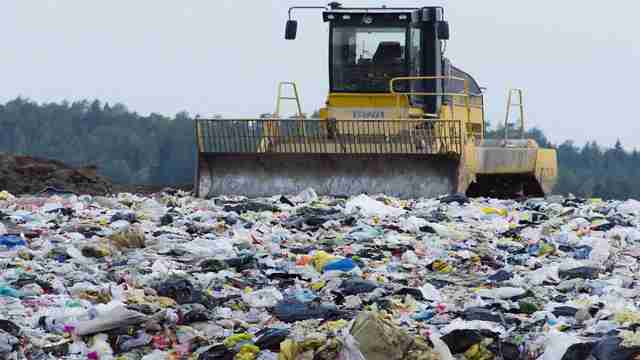
A solid waste management system consists of various components that work together to ensure that the system functions as effectively as possible.
The responsibility for the collection, segregation, storage, transportation, processing, and disposal of municipal solid waste lies within every municipality.
Municipal Solid Waste (Management & Handling) Rules, 2000 governs the overall management in Schedule (I-IV) as shown below.

MSW Generation
I compared CPCB annual report for every ten years and found that municipal solid waste generation is on an increasing trend:-
| Year | Quantity (Tons/Day) |
| 2000 | 1,00,000 |
| 2010-11 | 1,27486 |
| 2019-20 | 1,52,076 |
MSW Collection & Transportation [Garbage Management]
The responsibility for collecting and transportation of municipal solid waste lies within the government or the private company, and both need to follow the Solid Waste Management Rules, 2016.
Methods of Collection
Municipalities are responsible for collecting solid waste in cities, towns, and urban areas notified by the government.
They use the following collection methods:
- Street bins collection
- Door-to-door collection
- Street sweeping & putting in roadside bins
- Collection at a predefined interval
Transportation of MSW
In big cities, Compactor trucks collect the solid waste from the bins kept in the streets and transport them to a nearby collection point or the dumpsite.
However, in small towns and rural areas, open trucks, dumper trucks are used for waste collection and transportation.
This is usually done twice a week or on a weekly basis.
Recyclable materials (paper, plastic, glass, and metal) are usually segregated at the collection points, and sold to private scrap dealers.
Then, the compactors transport the remaining waste from the collection point to a transfer station.
The waste materials are shifted from compactors to a heavy truck at transfer stations that transports the solid waste to a dumpsite for final disposal.
Waste Management Hierarchy
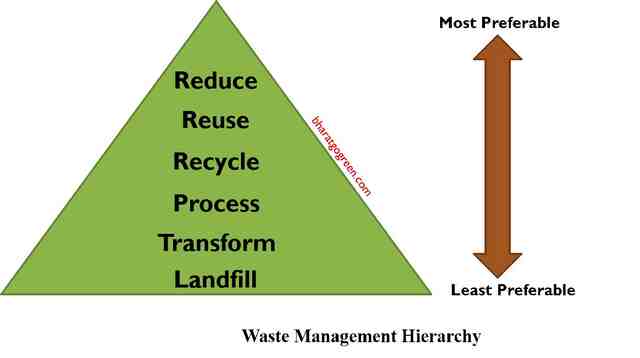
The solid Waste Management system proposes a waste management hierarchy to reduce waste being disposed of while maximizing resource conservation and resource efficiency.
1. Waste Segregation (3R Concept)
The biggest hurdle for an effective MSW management system is the segregation of waste.
Today, most Indian municipalities dispose of the majority of solid waste materials through conventional means.
They do waste collection, landfilling, treatment, and storage but often ignore the critical component – waste segregation.
Effective waste management requires sorting and segregation of different types of wastes.
When hazardous & non-hazardous wastes are mixed, the combined lot becomes hazardous too. It then becomes difficult to recycle, and its disposal cost also increases.
Other poor waste management practices are:
- Improper waste collection.
- Lack of transportation in some areas.
- Lack of finances.
- Unavailability of advanced treatment technologies.
Waste reduction at source
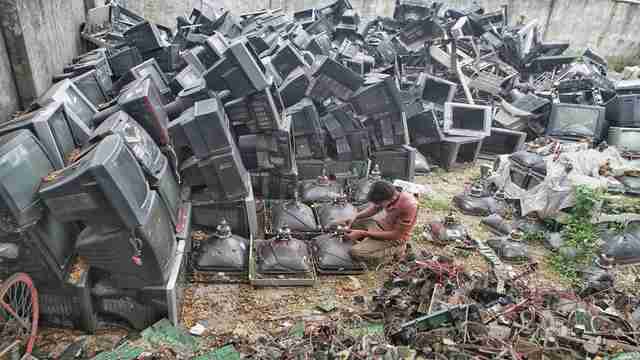
Reduce:
It means minimizing the quantity of a waste stream at its source.
We can reduce the amount of solid waste generation by using green raw materials, optimizing the product design, accessing its life cycle, and reducing energy & heat losses.
‘Reduce’ is on the top of the hierarchy. It proves to be the most effective means of cost reduction and causing less impact on the environment.
Reuse:
Reuse means utilization.
Using the same products again and consuming lesser raw materials can further reduce waste generation.
For example, using waste tin cans or glass jars as multipurpose containers for storage or plantation.
Recycle / Resource Recovery
It involves using waste as raw materials for making other stuff.
Recycling is to sort various recyclable and useful stuff like plastic, metal, glass, paper, etc., from solid waste and making new products.
In India, independent rag pickers, who are the poorest people, are efficient waste recyclers.
These people normally collect the recyclable materials from dumped solid waste and directly sell them to private dealers, who further sell them to various recycling companies.
| More to Read: |
2. Solid Waste Processing & Treatment

Do you know which is the most common solid waste treatment method in India?
They are non-controlled burning and improper disposal on open dumpsites, which is hazardous for health & the environment.
Necessary pre-treatment is required for the remaining solid waste before landfilling.
The prime objective of this treatment is:
- Toxicity reduction
- Volume reduction
- Physical & Chemical characteristics improvement
Please note that treatment methods of hazardous and industrial wastes are pretty different from MSW.
Let us discuss some standard methods of solid waste processing and treatment.
a. Composting
Composting is a biological process of solid waste decomposition and stabilization in the presence or absence of oxygen by using microbes.
This process works well with the organic portions of municipal waste, waste from dairy products, and agricultural wastes.
Compost is most widely used as soil conditioning in India.
b. Biomethanation
Biomethanation or Methanogenesis is an anaerobic process of converting organic wastes into biogas and manure by using microorganisms.
This process decomposes the biodegradable solid wastes in the absence of oxygen.
Methane-rich biogas finds its application in electricity generation and cooking purposes.
Biomethanation is a recognized technology for the agricultural waste and sewage sludge treatment in India. Still, its application is less for the MSW.
c. Incineration
Incineration is a combustion process that involves the burning of waste in the presence of oxygen.
It requires high temperature ranging between 980 to 2000 °C, and the final products are CO2, water vapor, and ash with a large amount of recoverable heat.
Incineration reduces the final waste volume by 75%, reduces transportation costs and greenhouse gas emissions.
However, garbage burning can cause certain pollutants (such as mercury, lead, and dioxins) release into the atmosphere causing health issues.
d. Pyrolysis & Gasification
Pyrolysis is a thermal degradation process in the absence of air that yields recyclable products such as char, oil/wax, and combustible gases.
The gasification process uses some oxygen to produce gaseous components. In contrast, the main products of pyrolysis are liquid residues and charcoal.
At present, there are no commercial pyrolysis and gasification plants for municipal solid waste treatment in India but available for other types such as agricultural waste.
3. Waste Transformation
Mechanical decomposition and autoclaving fall under this category.
In This process, the waste is transformed by combustion without recovering the resources.
4. Landfilling and/or Open Dumping
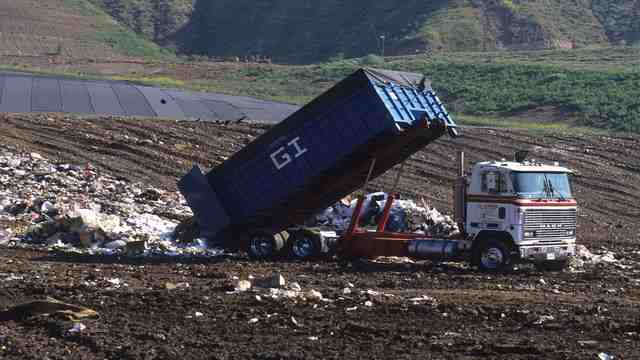
Many developing countries like India dispose of their waste in an open area without any precautions or pre-treatment.
Open dumping of solid waste can cause underground water pollution, foul smell to nearby areas, and gas emissions resulting in excessive air pollution.
To get rid of this problem, municipalities must follow the secure and sanitary landfilling practice.
Secure landfill can manage hazardous solid waste whereas Sanitary landfill takes care of MSW.
Landfills design must include:
- Composite liners to stop leachate percolation into underground water level.
- Collecting and ventilation system to collect produced gases.
Conclusion
India is one of the most populated countries and the fastest-growing economy globally, so it cannot afford ineffective solid waste management.
Today, most solid waste materials are disposed of through traditional means by most municipalities that include waste collection, landfills, treatment, and storage facilities.
Solid waste management systems act as the interface between various institutions regarding waste generation processes.
While all of these processes are equally important and necessary, one key component that authorities cannot ignore is the proper segregation from the resulting waste product.
There is a marked improvement in solid waste management practices in recent years. Still, the improvement to be at a faster pace.
Public awareness and their involvement in managing solid waste are more important.
What are your thoughts on Solid waste management?
Please provide your valuable comments below and share this article to help others.
To join the Save Environment bandwagon consider subscribing bharatgogreen.
References
- Kurian J., Lessons from municipal solid waste processing initiatives in India, available at http://www.swlf.ait.ac.th/UpdData/International/LESSONS%20FROM%20msw.pdf
- Central Pollution Control Board, Municipal solid waste guideline, available at https://cpcb.nic.in/technical-guidelines/
- www.indiaenvironmentportal.org.in
- Municipal Solid Wastes (Management and Handling) Rules, 2000, CPCB
- Municipal Solid Waste Management Manual by Central Public Health and Environmental Engineering Organization (CPHEEO)
- Camilla Axelsson & Theres Kvarnström, Energy from municipal solid waste in Chennai, India – a feasibility study
- Nandan, Abhishek & Yadav, Bikarama & Baksi, Soumyadeep & Bose, Debajyoti. (2017). Recent Scenario of Solid Waste Management in India. World Scientific News. 66. 56-74.